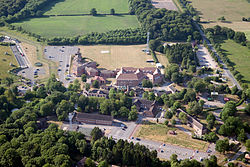Construction
Prior to the outbreak of the Second World War, the Air Ministry sought a safe location for RAF Bomber Command away from London. The wooded area near Naphill, Walters Ash and Lacey Green was suggested by Wing Commander Alan Oakeshott as ideal for this purpose, since the trees could provide natural camouflage from the air. [2]
Buildings were designed to resemble other uses, such as the Officers' Mess which was built to look like a manor house. The fire station was built with a tower to resemble a village church. Trees were preserved as much as possible to maintain the camouflage they provided. Roads were laid out so as to avoid most trees. The building work was carried out by John Laing and Son, [3] with 400 workmen and 80 specialists involved. Tunnels were dug to connect each block on the station, linked to an Operations Block built 55 feet (17 m) below ground. [2]
To preserve secrecy, the station was known as "Southdown" in March 1940, as part of a directive by the Air Ministry. The site's postal address was given as "GPO High Wycombe." [4]
Whilst High Wycombe was not an official flying station, a small airfield was used in the nearby village of Lacey Green, 1 mile (1.6 km) to the north. The airfield was unpaved and was used for small flights into and out of RAF High Wycombe and was only used between June 1944 and late 1945. [5] [6]
High Wycombe was also used by the 325th Photographic Wing, United States Army Air Forces, from 9 August 1944 until 20 October 1945. [7]
Post-War
Headquarters, 7th Air Division of the Strategic Air Command, supporting SAC operations in UK relocated to High Wycombe from RAF South Ruislip in 1958, and commanded all SAC operations from there until 1965. [8]
The station badge, incorporating a thunderbolt and two pillars to symbolise the support the station gave to Bomber Command, was approved on 23 November 1966. [9] RAF Bomber Command merged with RAF Fighter Command to form RAF Strike Command at RAF High Wycombe on 30 April 1968. [10] The station's title, Royal Air Force Station High Wycombe, was officially approved on 1 January 1969. [4] From 1983 to 1984 there was a peace camp protesting against the building of a bunker there at that time to house RAF Strike Command. [11]
On 1 July 1994, Headquarters Allied Forces North Western Europe (AFNORTHWEST) of NATO was established at High Wycombe. [12]
RAF Strike Command merged with RAF Personnel and Training Command to form RAF Air Command at RAF High Wycombe on 1 April 2007. [13] Since 2009, the station has been responsible for reviewing UFO sightings as part of efforts to identify any possible unauthorised military incursions into UK airspace. Civil servants tasked with reviewing such sightings relocated to the station from the Ministry of Defence Main Building in London. [14]
The Ministry of Defence and Serco agreed a ten-year contract in February 2010 whereby Serco would provide support services at RAF High Wycombe and RAF Halton, including leisure services, general engineering and catering. [15]
The actor David Jason officially opened the station's new welfare centre, named after Wing Commander Alan Oakeshott, in July 2011. [16] An Armed Forces Community Covenant between the station and Wycombe District Council was signed on 16 April 2012, designed to strengthen the links between the military and the local community. [17] Personnel exercised the station's Freedom of Wycombe District on 29 May 2012, parading through Princes Risborough. [18]





